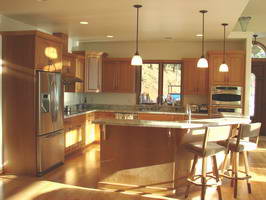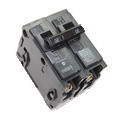Electrical Power Design for a Garage Workshop
 '; ';
|
I am planning a workshop in my garage where I will have 220 volt equipment: How to Install Wiring for a Garage Workshop. © By: Dave Rongey |
Wiring a Garage Workshop
Electrical Question: I am planning a workshop in my garage where I will have 220 volt equipment.
Workshop Wiring Project
I am building a home hobby workshop to run a 220volt, 2hp industrial lathe, stick welder, and 2HP sander.
- Garage 220Volt Requirements
One 4 prong receptacle.
One 3 three prong receptacle.
Each machine will be appropriately fused at the ON/OFF machine switch, so the 30 Amp dryer breaker will not play a role (of being over rated) on a 5 Amp, or 20 Amp machine for example.
I would like to make use of a 220volt 30amp dryer circuit in my garage. Bring the 220Volt, 10/2 drier cable into an industrial electrical enclosure (6 x 8 x 5) from the laundry room into the garage (laundry room and garage are back to back), the Cable will be connected VIA Hubbell HBL7810D Disconnect Switches, 30 Amp 600V, allowing me to switch between the dryer and garage.
- 220Volt Enclosure Functionality
Dryer ON, Garage OFF, Dryer OFF, Garage ON
Less desirable option:
I have a finished legal basement apartment, so a new line must be external. Plus, the inspector may insist to upgrade my panel to 200 amp service. This would be an expensive overkill for a hobbyist.
My last resort is to run a short extension into the laundry room, through an access hole in the wall and use the Dryer Plug as required when working in the garage. An extension cord is classified a temporary installation, needs no inspection, although it is somewhat inconvenient.
- Side note:
I submitted a request to my local Electrical Safety Authority, asking if my installation would be considered with in Code, on their question page. So far I have had three inspections and passed all.
This home electrical repairs question came from: Svata, from Brampton, Ontario, Canada.
Dave’s Reply:
Thanks for your home electrical question Svata
Power Design for a Garage Workshop
Application: Wiring a 30Amp Sub Panel for a Workshop.
Skill Level: Intermediate to Advanced – Best performed by a licensed electrician.
Tools Required: Electricians pouch of hand tools and the various power tools necessary for installing the garage sub panel.
Estimated Time: Depends on the type and size of the panel and available access to the project area.
Precaution: Any existing electrical wiring within the immediate area that may interfere with the installation of the sub panel should be identified and turned OFF and Tagged if necessary.
Notice: Installing additional garage electrical wiring and a sub-panel should be done according to local and national electrical codes with a permit and be inspected.
Planning Garage Workshop Electric Circuits
- Workshop Electrical Power Source From the information which is provided, there is an existing 30 amp circuit to the dryer which the homeowner wants to use as the power source for other equipment and receptacles.
- 4Wire Circuit Required I am going to assume that the 30 amp circuit is a 4-wire circuit that has a separate neutral and a separate ground, along with the 220 volt lines. The 4-wire circuit would be required if there would be 120 volt circuits needed, otherwise a 3-wire circuit would work fine for 220 volt circuits only.
- Electrical Circuits My concern with the proposed set up is the need to provide practical wiring and circuit distribution, but most importantly to provide proper circuit protection.
- What I would suggest is not to use the double throw switches set up, but instead consider installing a sub-panel and use the 30 amp dryer circuit as the power source, then install circuits for each of the other devices and one for the dryer as well.
- Each circuit will need to be rated as required for the equipment and protected by it’s own circuit breaker.
- A junction box may be required at the existing location of the dryer receptacle so the sub-panel and circuit wiring may be located in an approved and accessible location.
- The sub-panel would need to have enough available spaces for the number of circuit breakers that are needed.
- Amperage Power Limitation Keep in mind that you will be limited to the 30 amps of the original dryer circuit, so you will have to operate the larger loads individually to prevent tripping the 30 amp circuit breaker.
- As always, this electrical project should have a permit and the work should be inspected.
More about Garage Electrical Wiring
House Wiring Circuits and Circuit Breakers
This article looks at common 120 volt and 240 volt house wiring circuits and the circuit breakers that are installed identifying the types and amperage sizes used in most homes.
Home Electrical Circuit Breakers
Home Electrical Circuit Breakers
A guide to home electrical circuit breakers and how they work to protect your electrical wiring. When properly installed, your home electrical wiring is protected by a circuit protection device.
How to Install Workshop Electrical Wiring
Work Shop Electrical Wiring
Fully Explained Photos and Wiring Diagrams for Workshop Electrical Wiring with Code Requirements for most new or remodel projects.
Electrical Code Articles for Home Wiring
Electrical Code Directory covering electrical boxes, electrical circuits, electrical outlets, and electrical wiring methods.
The following may also be helpful for you:
|
|
Be Careful and Be Safe - Never Work on Energized Circuits!
Consult your Local Building Department about Permits and Inspections for all Electric Wiring Projects.
More articles about Electrical Wiring, Garage Electrical Wiring, Workshop Electrical Wiring and Home Electrical Wiring: |
|
| « Previous | Next » |
How to Update Basement Electrical Wiring |
Electrical Wiring for a Ceiling Fan |
















